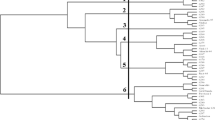Abstract
Red wild einkorn, Triticum urartu, is increasingly being recognized as a source of genetic material for the improvement of wheat grain quality and for conferring resistance to various diseases such as Powdery Mildew and Leaf Rust resistance including the virulent race Ug99. Two hundred and two samples of T. urartu collected throughout much of its distribution were investigated by amplified restriction length polymorphism, AFLP™ to estimate the genetic diversity within and among them. To infer the genetic structure of the populations the data were subjected to analyses of molecular variance, AMOVA. The analyses of the samples enabled us to assess the location(s) of the richest area(s) in genetic diversity of the species. This area is found in north-western Syria and the adjacent South Turkey. It was also found that the similarity among populations did not reflect on their geographic closeness.




Similar content being viewed by others
References
Baum BR, Bailey LG (2004) The origin of the A genome donor of wheats (Triticum: Poaceae)—a perspective based on the sequence variation of the 5S DNA gene units. Genet Resour Crop Evol 51:183–196
Dvorak J, di Terlizzi P, Zhang HB, Resta P (1993) The evolution of polyploid wheats, identification of the A genome donor species. Genome 36:21–31
Excoffier L (2000) Analysis of population subdivision. In: Balding D, Bishop M, Canning C (eds) Handbook of statistical genetics. Wiley
Excoffier L, Lischer H (2010) ARLEQUIN Ver 3.5.1.2. A software for population genetic data analysis. Genetics and Biometry Laboratory. University of Geneva, Switzerland. Accessed Dec 2010. http://cmpg.unibe.ch/software/arlequin35
Excoffier L, Smouse PE, Quattro JM (1992) Analysis of molecular variance from metric distances among DNA haplotypes: application to human mitochondrial DNA restriction data. Genetics 131:479–491
Gower JC (1971) A general coefficient of similarity and some of its properties. Biometrics 27:671–857
Hamrick JL, Linhart YB, Mitton JB (1979) Relationships between life history characteristics and electrophoretically detectable genetic variation in plants. Ann Rev Ecol Syst 10:173–200
Hartl DL, Clark AG (1997) Principles of population genetics, 3rd edn. Sinauer Associates, Sunderland
Hollingsworth PM, Ennos RA (2004) Neighbour joining trees, dominant markers and population genetic structure. Heredity 92:490–498
Huff DR, Peakall R, Smouse PE (1993) RAPD variation within and among natural populations of outcrossing buffalograss [Buchloë dactyloides (Nutt.) Engelm.]. Theor Appl Genet 86:927–934
Lewontin RC (1972) The apportionment of human diversity. Evol Biol 6:381–398
Maguire TL, Peakall R, Saenger P (2002) Comparative analysis of genetic diversity in the mangrove species Avicennia marina (Forsk.) Vierh. (Avicenniaceae) detected by AFLPs and SSRs. Theor Appl Genet 104:388–398
Mizumoto K, Hirosawa S, Nakamura C, Takumi S (2002) Nuclear and chloroplast genome genetic diversity in the wild einkorn wheat, Triticum urartu, revealed by AFLP and SSLP analyses. Hereditas 137:208–214
Moghaddam M, Ehdaie B, Waines JG (2000) Genetic diversity in populations of wild diploid wheat Triticum urartu Tum. ex Gandil. revealed by isozyme markers. Genet Resour Crop Evol 47:323–334
Nei M (1972) Genetic distance between populations. Amer Nat 106:283–292
Nei M (1973) Analysis of gene diversity in subdivided populations. Proc Nat Acad Sci USA 70(part 1): 3321–3323
Nei M (1978) Estimation of average heterozygosity and genetic distance from a small number of individuals. Genetics 89:583–590
Nei M (1987) Molecular evolutionary genetics. Columbia Univ Press, New York
Nevo E (1978) Genetic variation in natural populations: pattern and theory. Theor Popul Biol 13:121–177
Peakall R, Smouse PE (2006) GENALEX 6: genetic analysis in Excel. Population genetic software for teaching and research. Mol Ecol Notes 6: 288–295. Version 6.4 available at http://www.anu.edu.au/Bozo/GenAlEx/
Peakall R, Smouse PE, Huff DR (1995) Evolutionary implications of allozyme and RAPD variation in diploid populations of dioecious buffalograss Buchloë dactyloides. Mol Ecol 4:135–147
Rohlf FJ (2000) NTSYS-pc. Numerical taxonomy and multivariate analysis system. Ver 2.1. User guide. Exeter Software. Setauket, NY
Rouse MN, Jin Y (2011) Stem rust resistance in A-genome diploid relatives of wheat. Plant Dis 95:941–944
Sarle WS (1982) Cluster analysis by least squares. In: SAS users group international conference proceedings, vol SUGI7, pp 651–653
Sarle WS, An-Hsiang K (1993) The MODECLUS procedure. SAS Technical Report P-256. SAS Institute Inc, Cary
SAS Institute (2004) SAS/STAT® user’s guide. Ver 9.1, SAS Institute Inc., Cary
Sasanuma T, Chabane K, Endo TR, Valkoun J (2002) Genetic diversity of wheat wild relatives in the Near East detected by AFLP. Euphytica 127:81–93
Smith-Huerta NL (1986) Isozymic diversity in three allotetraploid Clarkia species and their putative diploid progenitors. J Hered 77:349–354
Smith-Huerta NL, Huerta AJ, Barnhart D, Waines JG (1989) Genetic diversity in wild diploid wheats Triticum monococcum var. boeoticum and T. urartu (Poaceae). Theor Appl Genet 78:260–264
Sokal RR, Michener CD (1958) A statistical method for evaluating systematic relationships. Univ Kansas Sci Bull 38:1409–1438
Vierling RA, Nguyen HT (1992) Use of RAPD markers to determine the genetic diversity of diploid wheat genotypes. Theor Appl Genet 84:835–838
Yaghoobi-Saray J (1979) An electrophoretic analysis of genetic variation within and between populations of five species in Triticum-Aegilops complex. PhD Thesis, University of California, Davis.
Yeh FC, Boyle T (1997) Population genetic analysis of co-dominant and dominant markers and quantitative traits. Belgian J Bot 129:157–163
Acknowledgments
This manuscript benefited from the careful comments of Dr. Stephen Molnar, Agriculture & Agri-Food Canada, Ottawa.
Author information
Authors and Affiliations
Corresponding author
Electronic supplementary material
Below is the link to the electronic supplementary material.
Rights and permissions
About this article
Cite this article
Baum, B.R., Bailey, L.G. Genetic diversity in the Red wild einkorn: T. urartu Gandilyan (Poaceae: Triticeae). Genet Resour Crop Evol 60, 77–87 (2013). https://doi.org/10.1007/s10722-012-9817-7
Received:
Accepted:
Published:
Issue Date:
DOI: https://doi.org/10.1007/s10722-012-9817-7




